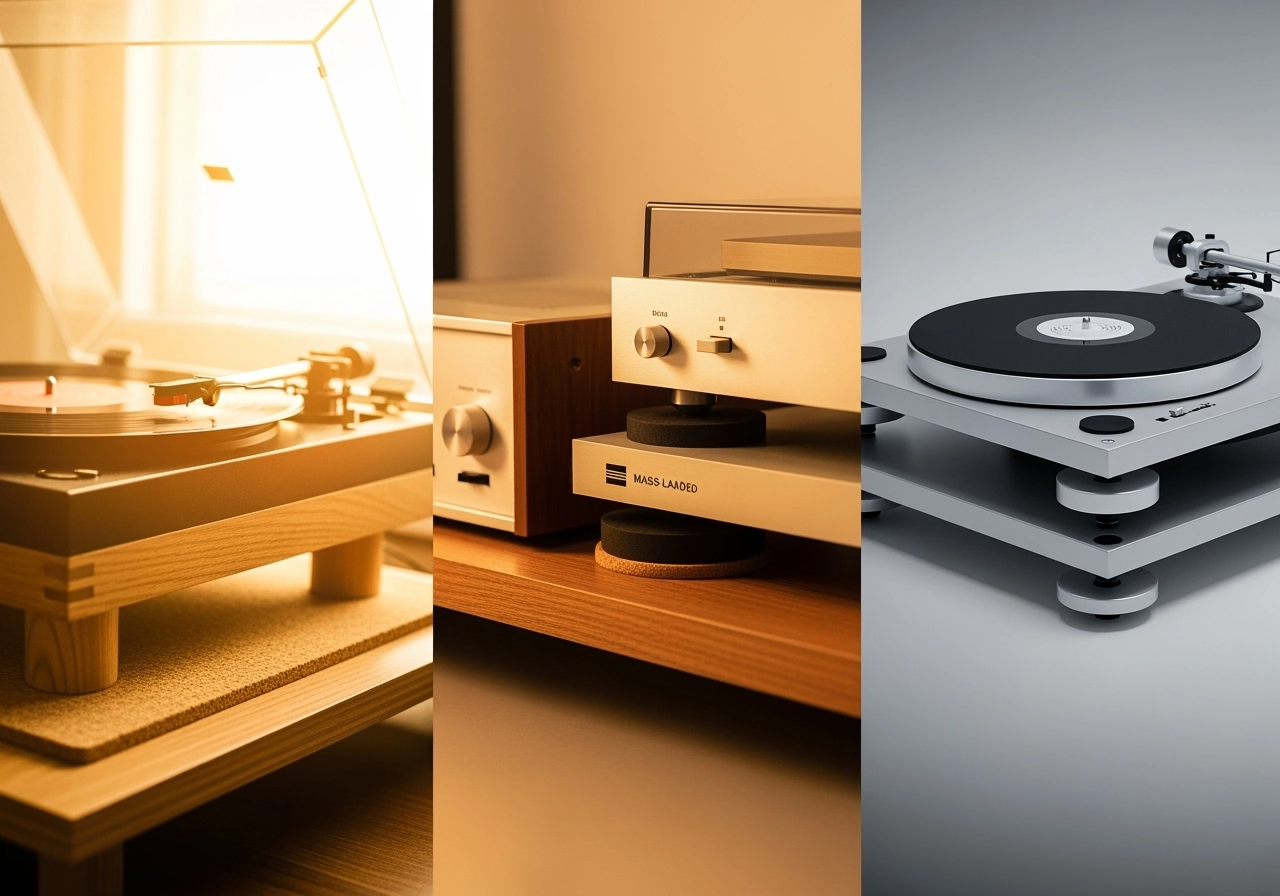The Evolution of Audio Vibration Control
For as long as there have been audiophiles, there has been a relentless pursuit of pure, uncolored sound. Early on, it became clear that unwanted vibrations were a major enemy of fidelity. The story of audio isolation is a narrative of this struggle, a progression from simple, ad-hoc solutions to the scientifically-engineered products we see today. It is a journey driven by a shared desire to quiet the noise floor and let the music speak for itself.
The DIY Era: A Tale of Trial and Error
In the nascent days of hi-fi, vibration control was a wild west of homemade solutions. Audiophiles in the 1970s and 80s, armed with little more than common sense and a desire to experiment, were the pioneers. They were trying to solve the problem of a skipping turntable and a muddy bass line with what they had on hand.
- Cork & Felt Mats: The most common starting point was the turntable mat. Vinyl records were thin, and platters often rang with a metallic resonance. The solution was simple: place a felt or cork mat between the record and the platter. This provided a degree of separation and damping, improving the sound over a naked platter.
- Tennis Balls & Inner Tubes: To isolate equipment racks, enthusiasts turned to items from the garage. Cut-up tennis balls, bicycle inner tubes, and even squash balls were used to create a makeshift isolation barrier under equipment feet. While these provided some decoupling, they lacked stability and were not tuned to specific frequencies.
- Mass Loading: The principle of using mass to resist motion became popular. Audiophiles would place heavy items like concrete pavers or granite slabs under their components. The idea was to create an incredibly heavy foundation that would resist being moved by vibrations.
While these early solutions were often effective at a basic level, they were unpredictable and lacked the precision to address the full spectrum of vibrational frequencies.
The Rise of Commercial Isolation: The Dawn of Science
As the audiophile market matured, so did the understanding of acoustics and materials science. Manufacturers began to move beyond simple, mass-based solutions to create products that were engineered for performance.
- Mass-Loaded Platforms: Companies began to produce platforms specifically designed to isolate components. These were often multi-layered “sandwiches” of different materials like MDF, steel, and lead shot, designed to dissipate energy through a process of constrained layer damping.
- Sorbothane: The discovery of materials like Sorbothane was a game-changer. This viscoelastic polymer was incredibly effective at absorbing and converting vibrational energy into heat. Its use in component feet and pucks allowed for a high degree of isolation in a compact form factor.
This era marked a crucial shift: isolation was no longer just a hobbyist’s pursuit; it was a recognized and scientifically-backed part of audio system optimization.
The Modern Era: Precision and Advanced Materials
Today, the field of audio isolation is driven by advanced materials and a deep understanding of resonance frequencies. Products are designed not just to dampen sound, but to manage and dissipate specific frequencies to an almost microscopic degree.
- Engineered Mats: Modern mats, like those from MITMATS, move beyond simple felt or cork. They use complex, rigidized foam matrices to actively absorb and convert vibrational energy. These mats are tuned to work with different platter materials and are designed to solve problems like platter ringing and static buildup, all while maintaining a low mass.
- Air Suspension & Magnetic Levitation: At the highest end of the market, some manufacturers use technologies like air suspension or magnetic levitation to completely decouple a component from its environment. This creates a virtual “floating” system that is almost entirely immune to external vibration.
- Computer Modeling: Modern isolation products are developed using computer modeling and advanced measurement tools to ensure their effectiveness. This allows manufacturers to precisely engineer a product to manage specific frequencies and weight loads.
The journey from a coin under a turntable to today’s advanced, scientifically-backed products is a testament to the audiophile community’s relentless pursuit of better sound. It is a history of trial and error, a story of science, and a constant reminder that in audio, the quietest parts of the system are often the most important.
Q&A Section
Q: Is there still a place for DIY in today’s audiophile world? A: Absolutely. DIY solutions can be a great way to start experimenting with isolation without a large financial commitment. While professionally engineered products will almost always provide superior performance, DIY methods can still offer a significant and audible improvement.
Q: What is the biggest difference between a vintage mat and a modern one? A: A modern, engineered mat is designed with a specific purpose in mind—to actively dampen vibrations using advanced materials. A vintage mat, like a simple felt one, was primarily intended to provide a soft surface and protect the record, with damping being a secondary and often limited benefit.
Q: Why do audiophiles care so much about resonance? A: Resonance, or unwanted vibration, is essentially a form of noise. By eliminating this noise, you lower the system’s “noise floor,” which allows the true music to emerge with greater clarity, detail, and dynamics. It is about revealing what was always there but was previously hidden by distortion.
